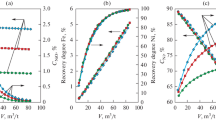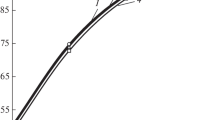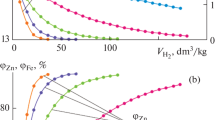Abstract
Ferronickel, currently obtained from oxidized nickel ores in various aggregates, contains from 5 to 20% of Ni. According to experiments, rich ferronickel (with a content of Ni of about 70%) can be obtained from the melt of silicate-nickel ore treated with reducing gas. The thermodynamic modeling of metallurgical processes, adapted to open systems, is used to consider the features of reducing the high-iron nickel ore from the Serovskoye deposit with carbon monoxide. The oxide melt composition used for the calculations includes 60.4 wt % of Fe2O3, 1.4 wt % of NiO, 0.14 wt % of СоО, 5.8 wt % of А12O3, 17 wt % of SiO2, 4.2 wt % of MgO, and 11.1 wt % of CaO. The simulation was carried out at a pressure of 0.1 MPa, an amount of carbon monoxide of 10.6 dm3/kg per portion, and temperatures of 1673, 1723, 1773 K. During calculations, dependencies are found that connect the content of nickel (CNiO), iron (\({{C}_{{{\text{F}}{{{\text{e}}}_{2}}{{{\text{O}}}_{3}}}}},\) \({{C}_{{{\text{F}}{{{\text{e}}}_{3}}{{{\text{O}}}_{4}}}}},\) CFeO) and cobalt (ССoО) oxides in the oxide melt and metals in the alloy (СNi, СFe, СCo), as well as their transition degree from the metallic state (φNi, φFe , φCo) to the amount of introduced gas. The component contents in one portion of reduced metal are determined. At temperatures of 1673 to 1773 K and an introduced amount of CO of 190 dm3/kg, the respective content of Fe2O3, Fe3O4, FeO, NiO, and CoO in the oxide melt is 0.17 to 0.12%, 1.77 to 1.05%, 55.6 to 56.5%, 0.026 to 0.037%, and 0.061 to 0.068%. At a nickel reduction degree of 98%, the respective degrees of iron and cobalt reduction are 5 and 56 to 61%. An alloy formed from the reduced metals contains about 30% of Ni, 63 to 65% of Fe and 2% of Co. Thus, it is shown that the selective reduction of nickel and cobalt is possible in certain conditions. The findings from the study are significant to validating the parameters of the production process of ferronickel from oxidized high-iron nickel ores.



Similar content being viewed by others
REFERENCES
Leont’ev, L.I., Vatolin, N.A., Shavrin, S.V., and Shumakov, N.S., Pirometallurgicheskaya pererabotka kompleksnykh rud (Pyrometallurgical Processing of Complex Ores), Moscow: Metallurgiya, 1997.
Yucel, O., Turan, A., and Yildirim, H., Investigation of pyrometallurgical nickel pig iron (NPI) production process from lateritic ores, Proc. 3rd Int. Symp. on High Temperature, Pittsburgh, PA: Miner., Met. Mater. Soc., 2012, pp. 17–23.
Yildirim, H., Morcali, M.H., Turan, A., and Yucel, O., Nickel pig iron production from lateritic nickel ores, Proc. Thirteenth Int. Ferroalloys Congr. “INFACON XIII,” Almaty, Kazakhstan, June 9–12, 2013, Karaganda: P. Dipner, 2013, pp. 237–244.
Kruger, P., Silva, C.A., Vieira, C.B., Araujo, F.G.S., and Seshadri, V., Relevant aspects related to production of iron nickel alloys (pig iron containing nickel) in mini blast furnaces, Proc. Twelfth Int. Ferroalloys Congr. “Sustainable Future,” Helsinki, Finland, June 6–9, 2010, Helsinki: Outotec Oyj, 2010, pp. 671–681.
Turan, A., Yucel, O., and Yildirim, H., Nickel pig iron (NPI) production from domestic lateritic nickel ores using induction furnace, Proc. 1st Int. Iron and Steel Symp., April 2–4, 2012, Karabuk, 2012, pp. 337–344.
Reznik, I.D., Ermakov, G.P., and Shneerson, Ya.M., Nikel’. Monografiya (Nickel: Monograph), Moscow: Nauka i Tekhnologiya, 2001, vol. 2.
Kotze, I.J., Pilot plant production of ferronickel from nickel oxide ores and dusts in a DC arc furnace, Miner. Eng., 2002, vol. 15, no. 11, pp. 1017–1022. https://doi.org/10.1016/S0892-6875(02)00127-9
Tarasov, A.V. and Paretskii, V.M., Modern role of electric melting in production of heavy non-ferrous metals, Elektrometallurgiya, 2003, no. 5, pp. 12–23.
Reynolds, Q.G. and Jones, R.T., Semi-empirical modeling of the electrical behavior of DC-arc smelting furnaces, J. S. Afr. Inst. Min. Metall., 2004, vol. 6, pp. 1–7.
Keskinkilic, E., Nickel laterite smelting processes and some examples of recent possible modifications to the conventional route, Metals, 2019, vol. 9, no. 9, pp. 974–990. https://doi.org/10.3390/met9090974
Kovgan, P.A., Abuov, M.G., and Edil’baev, A.I., Promising technologies for processing poor oxidized nickel ores, Tsvetn. Met., 2008, no. 2, pp. 43–45.
Tsymbulov, L.B., Knyazev, M.V., Tsemekhman, L.Sh., et al., Analysis of the variants of technological scheme for oxidized nickel ores processing into ferronickel using a two-zone Vanyukov’s furnace, Tsvetn. Met., 2010, no. 10, pp. 15–21.
Bystrov, V.P., Fedorov, A.N., Shchelkunov, V.V., and Bystrov, S.V., Using the Vanyukov process for processing oxidized nickel ores, Tsvetn. Met., 2011, nos. 8–9, pp. 155–158.
Bakker, M.L., Nikolic, S., and Mackey, P.J., ISASMELT™ TSL applications for nickel, Miner. Eng., 2011, vol. 24, no. 7, pp. 610–619. https://doi.org/10.1016/j.mineng.2010.09.016
Krasheninnikov, M.V., Marshuk, L.A., and Leont’ev, L.I., Selective reduction of nickel from oxide melt, Rasplavy, 1998, no. 4, pp. 45–48.
Vatolin, N.A., Moiseev, G.K., and Trusov, B.G., Termodinamicheskoe modelirovanie v vysokotemperaturnykh neorganicheskikh sistemakh (Thermodynamic Modeling in High Temperature Inorganic Systems), Moscow: Metallurgiya, 1994.
Belov, G.V. and Trusov, B.G., Termodinamicheskoe modelirovanie khimicheski reagiruyushchikh sistem (Thermodynamic Modeling of Chemically Reacting Systems), Moscow: MGTU, 2013.
Pickles, C.A., Harris, C.T., Peacey, J., and Forster, J., Thermodynamic analysis of the Fe–Ni–Co–Mg–Si–O–H–S–C–Cl system for selective sulphidation of a nickeliferous limonitic laterite ore, Miner. Eng., 2013, vol. 54, pp. 52–62. https://doi.org/10.1016/j.mineng.2013.03.029
Sohn, H.Y., Process modeling in non-ferrous metallurgy, in Treatise on Process Metallurgy: Industrial Processes, Oxford: Elsevier, 2014, ch. 2.4, pp. 701–838.
Elliott, R., Pickles, C.A., and Forster, J., Thermodynamics of the reduction roasting of nickeliferous laterite ores, J. Miner. Mater. Charact. Eng., 2016, vol. 4, pp. 320–346. https://doi.org/10.4236/jmmce.2016.46028
Vusikhis, A.S., Dmitriev, A.N., Kudinov, D.Z., and Leontiev, L.I., The study of liquid and gas phases interaction during the reduction of metal oxides from the melts by gas reductant in bubbled layer, Proc. 3rd Int. Conf. on Mathematical Modeling and Computer Simulation of Materials Technologies (MMT–2004), Ariel, 2004, pp. 72–77.
Dmitriev, A., Leontiev, L., Vusikhis, A., and Kudinov, D., Liquid and gas interactio during reduction in bubbled layer, Proc. European Metallurgical Conf. EMC’2005, Dresden, Germany, September 18–21, 2005, Dresden, 2005, vol. 3, pp. 1349–1358.
Slag Atlas, Düsseldorf: Stahl und Eisen, 1995, 2nd ed.
Raynor, G.V. and Rivlin, V.G., Co–Fe–Ni in Phase Equilibria in Iron Ternary Alloys, London: Inst. Met., 1988, pp. 247–255.
Funding
This work was performed under the State Assignment of the Institute of Metallurgy (UB RAS) within the framework of the Program of Basic Research of State Academies.
Author information
Authors and Affiliations
Corresponding author
Additional information
Translated by S. Kuznetsov
About this article
Cite this article
Vusikhis, A.S., Selivanov, E.N., Sergeeva, S.V. et al. Thermodynamic Modeling of Metal Reduction from Oxidized High-Iron Nickel Ore Melts. Steel Transl. 51, 22–26 (2021). https://doi.org/10.3103/S0967091221010137
Received:
Revised:
Accepted:
Published:
Issue Date:
DOI: https://doi.org/10.3103/S0967091221010137




